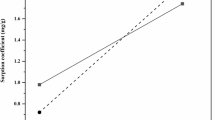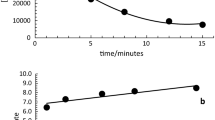Abstract
This study describes the decomposition of polychlorinated biphenyls (PCBs) in soil with dispersion mixtures of metallic calcium (Ca) and calcium oxide (CaO) at different temperatures. In these experiments, naturally moisturized and contaminated soil (1.0 g [31 ppm PCBs]), CaO (dried 2.0 wt%), and metallic Ca (0.01 g [0.25 mmol]) were introduced into a stainless steel pressure reactor under 0.1 MPa N2 gas. The mixtures were stirred magnetically and heated at 260, 280, and 300 °C, respectively. Soil treatment with metallic Ca and CaO under various temperature conditions is extremely effective for degrading existing PCBs. Decomposition resulted from dechlorination (DC). Initial moisture in soil acted as a hydrogen source during stirring. Soil moisture can be beneficial for hydrodechlorination in the presence of metallic Ca and CaO. Furthermore, metallic Ca and CaO can greatly increase the number of collisions and mutual refinement. Treatment at 260, 280, and 300 °C combined with metallic Ca and CaO is effective for the decomposition (approximately 95 % DC) of PCBs in soil under natural moisture conditions.




Similar content being viewed by others
References
Aken BV, Correa PA, Schnoor JL (2012) Phytoremediation of polychlorinated biphenyls: new trends and promises. Environ Sci Technol 15:2767–2776
Drenzek NJ, Eglinton TI, Wirsen CO, Sturchio NC, Heraty LJ, Sowers KR et al (2004) Invariant chlorine isotopic signatures during microbial PCBs reductive dechlorination. Environ Pollut 128:445–448
Ficko S, Rutter A, Zeeb B (2010) Potential for phytoextraction of polychlorinated biphenyls (PCBs) from contaminated soils using weeds. Sci Total Environ 408:3469–3476
Ghattas A, Abu-Reziq R, Avnir D, Blum J (2003) Exhaustive hydrodechlorination of chlorinated aromatic environmental pollutants to alicyclic compounds. Green Chem 5:40–43
Greenwood S, Rutter A, Zeeb BA (2011) The absorption and translocation of polychlorinated biphenyl congeners by Cucurbita pepo ssp. pepo. Environ Sci Technol 45:6511–6516
Grittini C, Malcomson M, Fernando Q, Korte N (1995) Rapid dechlorination of polychlorinated biphenyls on the surface of a Pd/Fe bimetallic system. Environ Sci Technol 29:2898–2900
He N, Li P, Zhou Y, Ren W, Fan S, Verkhozina VA (2009) Catalytic dechlorination of polychlorinated biphenyls in soil by palladium–iron bimetallic catalyst sufficient. J Hazard Mater 164:126–132
Hunt L, McKinley J, McElroy R (2006) Sonication treatment of polychlorinated biphenyl contaminated media, United States patent no. 6984767. Sonic Environmental Solutions, Vancouver
Japanese Industrial Standard Committee (1998) Methods for chemical analysis of high-alumina raw material for ceramics, JIS M 8856-1998. Japanese Industrial Standard Committee, Tokyo
Japanese Industrial Standard Committee (1999a) Test method for water content of soils, JIS A 1203-1999. Japanese Industrial Standard Committee, Tokyo
Japanese Industrial Standard Committee (1999b) Method for determination of tetra through octachlorodibenzo-p-dioxins, tetra-through octachlorodibenzofurans and coplanar polychlorobiphenyls in stationary source emissions, JIS K 0311-1999. Japanese Industrial Standard Committee, Tokyo, Japan
Japanese Industrial Standard Committee (1999c) Method for determination of tetra- through octachlorodibenzo-p-dioxins, tetra- through octachlorodibenzofurans and co-planar polychloro-biphenyls in industrial water and waste water, JIS K 0312-1999. Japanese Industrial Standard Committee, Tokyo
Kalinovich I, Rutter A, Poland JS, Cairns G, Rowe RK (2008) Remediation of PCB contaminated soils in the Canadian Arctic: excavation and surface PRB technology. Sci Total Environ 407:53–66
Kawai T (2005) Decontamination and detoxification technologies for persistent organic pollutants. Kobelco eco-solutions engineering reports, vol 1. Kobelco Eco-Solutions, Ho Chi Minh, pp 28–38
Knox A (2005) Overview of incineration: an overview of incineration and EFW technology as applied to the management of municipal solid waste (MSW). University of Western Ontario, Ontario
Langlois V, Rutter A, Zeeb BA (2011) Activated carbon immobilizes residual polychlorinated biphenyls (PCBs) at contaminated terrestrial sites. J Environ Qual 40:1130–1134
Leigh MB, Prouzova P, Mackova M, Macek T, Nagle DP, Fletcher JS (2006) Polychlorinated biphenyl (PCB)-degrading bacteria associated with trees in a PCB-contaminated site. Appl Environ Microbiol 72:2331–2342
Liu Y, Schwartz J, Cavallaro CL (1995) Catalytic dechlorination of polychlorinated biphenyls. Environ Sci Technol 29:836–840
Matsunaga K, Yamabe SI, Mori T (1997) Photodegradation of polychlorobiphenyls by titanium dioxide/ferric ion/hydrogen peroxide/UV light system. Japan J Toxicol Environ Health 43:174–181
Ministry of Environment, Government of Japan (2002) Soil contamination countermeasures law enforcement regulation, ordinance no. 29. Ministry of Environment, Government of Japan, Tokyo
Mitoma Y, Nagashima S, Simion C, Simion AM, Yamada T, Mimura K et al (2000) Dehalogenation of aromatic halides using metallic Ca in ethanol. Environ Sci Technol 35:4145–4148
Mitoma Y, Takase M, Yoshino Y, Masuda T, Tashiro H, Egashira N et al (2006a) Novel mild hydrodechlorination of PCDDs, PCDFs and co-PCBs inside fly ash using a calcium-promoted rhodium carbon catalyst in methanol. Environ Chem 3:215–218
Mitoma Y, Tasaka N, Takase M, Masuda T, Tashiro H, Naoyoshi E et al (2006b) Calcium-promoted catalytic degradation of PCDDs, PCDFs, and coplanar PCBs under a mild wet process. Environ Sci Technol 40:1849–1854
Mitoma Y, Egashira N, Simion C (2009) Highly effective degradation of polychlorinated biphenyls in soil mediated using a Ca/Rh bicatalytic system. Chemosphere 74:968–973
Mitoma Y, Miyata H, Egashira N, Simion A, Kakeda M, Simion C (2011) Mechanochemical degradation of chlorinated contaminants in fly ash with a calcium-based degradation reagent. Chemosphere 83:1326–1330
Miyoshi K, Nishio T, Yasuhara A, Morita M, Shibamoto T (2004) Detoxification of hexachlorobenzene by dechlorination with potassium–sodium alloy. Chemosphere 55:1439–1446
Monagheddu M, Mulas G, Doppiu S, Cocco G, Racanelli S (1999) The decrease of polychlorinated dibenzo-dioxins and dibenzofurans in contaminated muds by mechanically induced combustion reactions. Environ Sci Technol 33:2485–2488
Nomura Y, Nakai S, Hosomi M (2005) Elucidation of degradation mechanism of dioxins during mechanochemical treatment. Environ Sci Technol 39:3799–3804
Okamoto M, Ishimori Y, Toyohara N (1999) Photocatalyst material for decomposition of organic materials and prevention of growth of hazardous organic materials using the same. Japan patent no. 11188269, Toshiba
Okuno H, Yim B, Mizukoshi Y, Nagata Y, Maeda Y (2000) Sonolytic degradation of hazardous organic compounds in aqueous solution. Ultrason Sonochem 7:261–264
Rein A, Fernqvist MM, Mayer P, Trapp S, Bittens M, Karlson UG (2007) Degradation of PCB congeners by bacterial strains. Appl Microbiol Biotechnol 77:469–481
Tateishi M, Tsuchiyama Y, Yamauchi Y, Fukuzumi T, Hatano T (2000) PCB decomposition process, United States patent no. 6162958. Mitsubishi Heavy Industries, Tokyo
Ukisu Y, Miyadera T (2003) Hydrogen-transfer hydrodechlorination of polychlorinated dibenzo-p-dioxins and dibenzofurans catalyzed by supported palladium catalysts. Appl Cat B 40:141–149
United States Environmental Protection Agency (1994) Terra-Kleen solvent extraction technology. United States environmental protection agency report no. EPA/540/MR-94/521. EPA, San Diego
Varanasi P, Fullana A, Sidhu S (2007) Remediation of PCB contaminated soils using iron nano-particles. Chemosphere 66:1031–1038
Warren TP, Lindstrom FT (1985) Waste disposal technologies for polychlorinated biphenyls. Environ Health Perspect 59:163–177
Yan JH, Peng Z, Lu SY, Li XD, Ni MJ, Cen KF et al (2007) Degradation of PCDD/Fs by mechanochemical treatment of fly ash from medical waste incineration. J Hazard Mater 147:652–657
Youshi L, Manying M, Zhou S, Yan D, Xiaoxi Z, Ying H (2012) A study of remediation of PCB contaminated soil by a combination of biosurfactant washing, UV-irradiation and biodegradation. Adv Sci Lett 10:344–348
Zabelina ON, Saloutin VI, Chupakhin ON (2010) Analysis of polychlorinated biphenyl mixtures by gas chromatography. J Anal Chem 65:1098–1108
Acknowledgments
The authors gratefully acknowledge financial support for this study from the Industrial Technology Research Grant Program (Grants No. 04A47002 and 09B35003a) of the New Energy and Industrial Technology Development Organization of Japan and a Grant-in-Aid for Scientific Research (B) [KAKENHI: 20310046] from the Japan Society for the Promotion of Science. Special thanks are given to NHI Co., Ltd., Nihonkai Environmental Service Inc., and Sankyo Kosan Co., Ltd.
Author information
Authors and Affiliations
Corresponding author
Rights and permissions
About this article
Cite this article
Mitoma, Y., Mallampati, S.R., Miyata, H. et al. Decomposition of Polychlorinated Biphenyls in Soil With a Dispersion Mixture of Metallic Calcium and Calcium Oxide. Arch Environ Contam Toxicol 64, 180–186 (2013). https://doi.org/10.1007/s00244-012-9829-5
Received:
Accepted:
Published:
Issue Date:
DOI: https://doi.org/10.1007/s00244-012-9829-5




